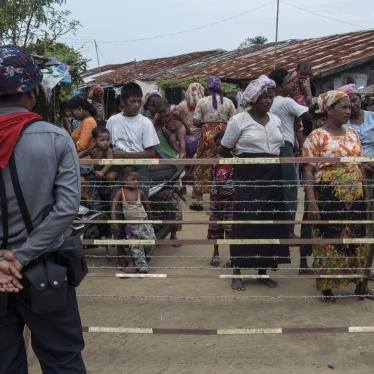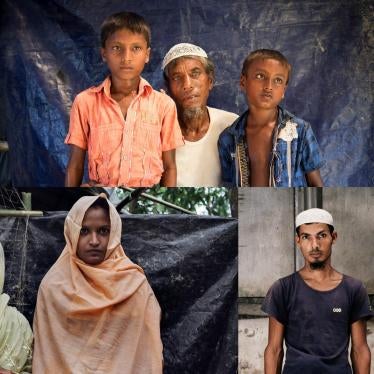(New York) – A new Sri Lankan Defense Ministry report concedes for the first time that government forces caused civilian deaths in the final months of the conflict with the Tamil Tigers but takes no responsibility for laws-of-war violations, Human Rights Watch said today. The report, “Humanitarian Operation – Factual Analysis,” issued on August 1, 2011, claims that government forces did not use artillery against populated areas despite considerable evidence to the contrary and ignores compelling evidence of summary executions by its soldiers.
The report states that government forces “adher[ed] to a ‘Zero Civilian casualty’ policy” in the final months of the war, which ended in May 2009. But it says that, “[I]t was impossible in a battle of this magnitude, against a ruthless opponent actively endangering civilians, for civilian casualties to be avoided.”
“The Sri Lankan government is finally admitting that its forces caused civilians losses during the conflict’s final months, but unconvincingly claims no responsibility,” said Brad Adams, Asia director at Human Rights Watch. “This is just the latest and glossiest effort to whitewash mounting evidence of government atrocities during the fighting.”
While the report details the numerous abuses over the years by the Tamil Tigers, on which Human Rights Watch and other organizations have reported, it provides no serious discussion of alleged war crimes by Sri Lankan forces, Human Rights Watch said. The report describes the Tamil Tigers’ use of “human shields,” shootings of civilians seeking to escape Tamil Tiger-controlled areas, and other abuses, but it ignores the Sri Lankan military’s role in civilian deaths, Human Rights Watch said. It notes the government’s unilateral declaration of no-fire zones (NFZs) and claims that: “[N]o artillery power was used in the NFZs. However, small arms fire including sniper attacks were used for the rescue operations.”
The report says nothing about Sri Lankan forces’ frequent indiscriminate shelling of civilian areas, causing thousands of civilian casualties. Nor is there any mention of the repeated shelling of hospitals by government forces. These attacks, over several weeks, were described comprehensively in the 2011 report of the United Nations Panel of Experts, the 2009 US State Department Report to Congress on Incidents During the Recent Conflict in Sri Lanka, and reports by nongovernmental organizations, including Human Rights Watch.
The Sri Lankan Presidential Secretariat itself effectively admitted in April 2009 to using heavy weapons in areas where there were civilians, stating: “Our security forces have been instructed to end the use of heavy caliber guns, combat aircraft and aerial weapons which could cause civilian casualties” (emphasis added).
No mention is made of allegations that government soldiers summarily executed captured Tamil Tiger fighters in the final days of the fighting, though the killings were captured on video. And while the report describes the military operations around the town of Mutur in Trincomalee district in August 2006, it says nothing about the execution-style killing of 17 humanitarian aid workers in Mutur at the time, allegedly by Sri Lankan security forces.
The report makes clear that military commanders relied heavily on photographs from unmanned aerial drones (UAVs): “The constant use of UAV pictures flashed to the forward commanders in up front positions were the most useful source to identify combatants with weapons, even though some of these were in civilian attire.”
“The use of unmanned aerial drones by Sri Lankan commanders to gain a clear picture of the battlefield raises concerns that artillery attacks on hospitals and other civilian areas were deliberate, and not mere mistakes resulting from the ‘fog of war,’” Adams said.
The report provides inadequate information on investigations by the Sri Lankan government into alleged war crimes by its forces. The report says, “There have been several instances where military personnel have been subject to indictments preferred [sic] by the Attorney General to the High Court,” but provides no details. It summarizes “major offenses” committed by Sri Lanka Army personnel between 2005 and 2010 in the North and East, and lists eight convictions for murder, four for rape, and one for sexual abuse. However, no indication is given as to whether these were crimes committed during military operations or were common crimes, or of the sentences handed down.
Violations of the laws of war by the Tamil Tigers did not justify abuses by government security forces, Human Rights Watch said. Human Rights Watch reiterated its call for an independent international investigation into violations of the laws of war by both sides to the conflict.
“The Sri Lankan Defense Ministry report is yet another feeble attempt to convince the world, despite growing evidence to the contrary, that government forces committed no crimes in the conflict with the Tamil Tigers,” Adams said. “Concerned governments should use this factually challenged report to jump-start international accountability efforts as the UN Panel of Experts recommended.”








